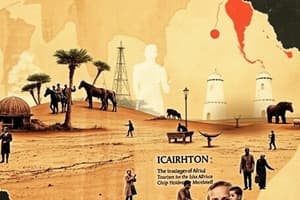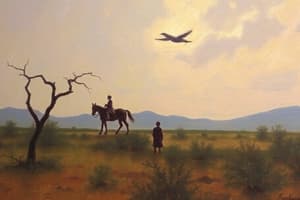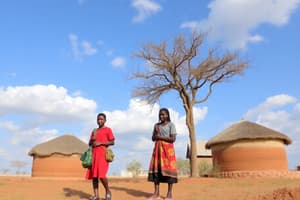Podcast
Questions and Answers
Which of the following best describes the primary method used by the Emirate of Harar to extend its authority?
Which of the following best describes the primary method used by the Emirate of Harar to extend its authority?
- Imposing heavy taxes and creating vassal states
- Military conquest and forced subjugation
- Political alliances with European powers
- Trade, inter-marriage, and Islamic teachings (correct)
Who is traditionally considered the founder of the Shewan branch of the 'Solomonids'?
Who is traditionally considered the founder of the Shewan branch of the 'Solomonids'?
- Merid Azmatch Sebestie
- Abuye/Abiyye
- Negasi Kristos (correct)
- Ainaha Iyesus
What was the main function of the Majlis in the Emirate of Harar?
What was the main function of the Majlis in the Emirate of Harar?
- To serve as the Emir's personal bodyguard.
- To manage mosque land (waqf). (correct)
- To oversee trade relations with other emirates.
- To command the military forces.
Which of the following groups did King Abuye fail to subjugate, ultimately leading to his demise?
Which of the following groups did King Abuye fail to subjugate, ultimately leading to his demise?
Which leader shifted the capital of Shewa from Doqaqit to Ankober?
Which leader shifted the capital of Shewa from Doqaqit to Ankober?
During whose reign did Harar become a walled city?
During whose reign did Harar become a walled city?
What was a common method of interaction between the various peoples and states mentioned in the text?
What was a common method of interaction between the various peoples and states mentioned in the text?
Which of the following areas were not conquered by Asfa-Wosen during his rule in Shewa?
Which of the following areas were not conquered by Asfa-Wosen during his rule in Shewa?
What was the staple crop in Gurage?
What was the staple crop in Gurage?
Which title combined political and military authority among Gurage leaders?
Which title combined political and military authority among Gurage leaders?
What formed the nucleus of the state of Kambata?
What formed the nucleus of the state of Kambata?
Which of the following crops were major cash crops in the Silte highland areas?
Which of the following crops were major cash crops in the Silte highland areas?
What traditional governance system was utilized by the Halaba?
What traditional governance system was utilized by the Halaba?
What is a distinguishing feature of Hadiya's political structure?
What is a distinguishing feature of Hadiya's political structure?
Which community is primarily associated with the origins of the Anywa state?
Which community is primarily associated with the origins of the Anywa state?
Which community has the traditional institution called Hambericho Council?
Which community has the traditional institution called Hambericho Council?
The Nuer community is primarily located in which geographical areas?
The Nuer community is primarily located in which geographical areas?
What type of governance system was employed by the Anywa?
What type of governance system was employed by the Anywa?
Which major ethnic group is traced among the descendants of Hadiya?
Which major ethnic group is traced among the descendants of Hadiya?
What were the traditional methods of agriculture practiced by the Majang?
What were the traditional methods of agriculture practiced by the Majang?
Which major cash crops are recorded in Halaba's economy?
Which major cash crops are recorded in Halaba's economy?
What role did Nayyi Aliye play in the history of Silte?
What role did Nayyi Aliye play in the history of Silte?
Flashcards
Emirate of Harar
Emirate of Harar
A historical state in Eastern Africa, known for being walled and ruled by various Amirs.
Nur Mujahid
Nur Mujahid
The ruler during whose reign Harar became a significant walled city.
Majlis
Majlis
The council that assisted Amirs in the Emirate of Harar, overseeing mosque land.
Kingdom of Shewa
Kingdom of Shewa
Signup and view all the flashcards
Negasi Kristos
Negasi Kristos
Signup and view all the flashcards
Abuye/Abiyye
Abuye/Abiyye
Signup and view all the flashcards
Ainaha Iyesus
Ainaha Iyesus
Signup and view all the flashcards
Afar and Argobba
Afar and Argobba
Signup and view all the flashcards
Shewa's economy
Shewa's economy
Signup and view all the flashcards
Gurage groups
Gurage groups
Signup and view all the flashcards
Yajoka Qicha
Yajoka Qicha
Signup and view all the flashcards
Enset
Enset
Signup and view all the flashcards
Silte movement
Silte movement
Signup and view all the flashcards
Khat and berbere
Khat and berbere
Signup and view all the flashcards
Hadiya state origin
Hadiya state origin
Signup and view all the flashcards
Queen Elleni
Queen Elleni
Signup and view all the flashcards
Kambata state formation
Kambata state formation
Signup and view all the flashcards
Hambericho Council
Hambericho Council
Signup and view all the flashcards
Halaba administrative system
Halaba administrative system
Signup and view all the flashcards
Anywa governance
Anywa governance
Signup and view all the flashcards
Majang lifestyle
Majang lifestyle
Signup and view all the flashcards
Nuer age-set system
Nuer age-set system
Signup and view all the flashcards
Kunama customary institution
Kunama customary institution
Signup and view all the flashcards
Study Notes
Peoples and States in Eastern, Central, Southern, and Western Regions
- Detailed study of all peoples and states impossible in a brief module; this section highlights examples.
- Regional peoples and states had connections through trade and other interactions.
Peoples and States in the East
- Emirate of Harar:
- Nur Mujahid's reign saw Harar become a walled city.
- Ali ibn Da’nd established a dynasty lasting over two centuries.
- Amirs like Abdul Shakur strengthened the emirate.
- The Majlis (council) supervised mosque land (waqf) and supported the Amirs.
- Amirs expanded authority over surrounding groups (Afar, Argobba, Oromo, Somali) through trade, marriage, and Islam.
Peoples and States in Central and South Central Parts
-
Kingdom of Shewa:
- Negasi Kristos founded the kingdom, claiming descent from the Solomonic line.
- He established alliances with Argobba Muslims.
- Merid Azmatch Sebestie/Sebastyanos, Abuye/Abiyye, and Ainaha Iyesus/Ainhayyes were succeeding rulers.
- Ainaha Iyesus consolidated control over various districts (Bulga, Efrata, Menz, etc.). His capital later moved to Ankober.
- Asfa-Wosen expanded the kingdom by conquering surrounding territories (Antsokia, Asbo, etc.).
- Economy relied primarily on agriculture, supplemented by trade and crafts.
-
Gurage:
- Two major groups (Western/Sebat Bet, Northern/Kistane) with traditional governance structures (Yajoka Qicha, Gordanna Sera).
- No centralized leadership; power in descent/clan groups.
- Leaders held titles like 'abegaz' or 'azmatch' (political/military authority).
- Staple crop was enset.
-
Silte:
- Origins linked to people moving from eastern highlands, possibly related to conflicts with Christian kingdoms and Oromo.
- Ethnogenesis may have involved a mix of groups.
- Chief crops: enset (highlands) and cereals (lowlands).
- Additional cash crops included khat, berbere, and increasingly coffee.
-
Hadiya:
- Origin dates back to the 13th century.
- Population became more diverse after Christian-Adal wars and Oromo migrations.
- Relations with the Christian state were largely stable, particularly after a royal marriage.
- Notable subgroups include Mareko, Lemu, Soro, Shasliogo, and Badoivacho.
-
Kambata:
- Four separate communities (Kambata, Dubamo, Donga, Tembaro) coalesced around 1550-70 to form the Kambata state.
- Omotic and Seinitic peoples influenced state formation.
- Kambata Lamala were seven dominant clans.
- Administrative institution (Hambericho Council) with seven members representing clans.
- Staple crop was enset. Shared culture and language (Kambatissa).
-
Halaba:
- Lived between the Bilate River and Lake Hawasa.
- Indigenous administration led by a Woma (king) and clan/village leaders.
- Halabi Ogete (village leader assembly) handled societal issues and disputes.
- Administrative system based on Sera (laws and values).
- Economy focused on subsistence agriculture and livestock.
- Major crops included red pepper, maize, and teff. Kolito was a major market center.
Peoples and States in the West
-
Anywa:
- Predominantly lived along rivers (Pibor, Sobat, Gila, etc.).
- Local tradition traces origin to a founding father (Oshoda).
- Village governance led by a chief (kuaari) and nobles (nyiye).
-
Majang:
- Origin in the Boma plateau in South Sudan; settled around Dembi-Dollo.
- Practiced shifting cultivation, animal husbandry, beekeeping, hunting, and fishing.
-
Nuer:
- Lived in savannas and marshes of the Bahr el-Ghazal and Upper Nile regions.
- Largely settled in the Gambella plains along the Sobat and Baro Rivers since the 19th century.
- Had an age-set system with social and political functions.
- Boys had to pass through initiation rites.
-
Berta and Gumuz:
- Lived around the lower Abbay (Awash) River.
- Long trade contacts with northern Sudan led to strong Islamic influence.
- Gold deposits attracted other groups.
-
Kunama:
- Ancient inhabitants of western Eritrea (Gash and Tekkeze Rivers).
- Had a customary institution (sanga-anene) for administration, dispute resolution, and asylum.
- Matrilineal inheritance of the sanga-anene office.
- Staple crop was kina (sorghum). Other crops included millet, pulses, and maize. Kept goats, sheep, oxen, and camels.
Studying That Suits You
Use AI to generate personalized quizzes and flashcards to suit your learning preferences.




